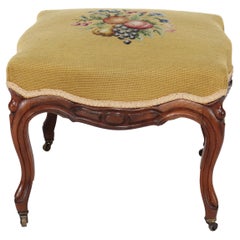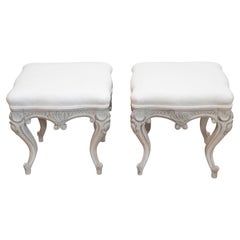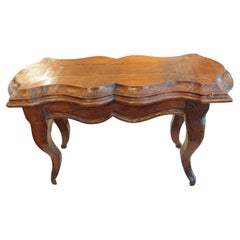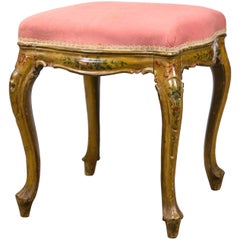Rococo Wood Footstools
Antique 19th Century Rococo Footstools
Rosewood
Antique Late 19th Century Swedish Rococo Footstools
Upholstery, Wood
Recent Sales
Antique Late 19th Century French Rococo Footstools
Oak
Antique Early 19th Century Italian Rococo Footstools
Wood
Antique 19th Century Hungarian Rococo Footstools
Giltwood
Antique 18th Century and Earlier French Rococo Stools
Giltwood
Antique 18th Century French Rococo Footstools
Tapestry, Giltwood
Antique 1750s Italian Rococo Footstools
Walnut
20th Century French Rococo Footstools
Giltwood
Antique Mid-19th Century English Rococo Benches
Bouclé, Wood
Antique 1740s Italian Rococo Benches
Walnut
Late 20th Century Italian Rococo Footstools
Cane, Wood, Wicker, Walnut
Antique 19th Century French Rococo Ottomans and Poufs
Textile, Wood
Antique 1750s Italian Rococo Footstools
Walnut
Antique Mid-18th Century Italian Rococo Benches
Walnut
Antique 19th Century Italian Rococo Stools
Wood
Antique Late 18th Century Swedish Rococo Footstools
Fabric, Pine
Antique Late 18th Century Dutch Rococo Benches
Walnut
Antique Late 19th Century Italian Rococo Footstools
Beech
Antique 18th Century French Rococo Footstools
Silk, Velvet, Giltwood
Antique 18th Century Italian Rococo Footstools
Wood
Vintage 1910s Swedish Rococo Footstools
Birch
Antique 19th Century Italian Rococo Footstools
Wood
Antique 19th Century Spanish Rococo Stools
Wood
Antique Mid-19th Century French Rococo Footstools
Tapestry, Giltwood
Antique Late 19th Century French Rococo Footstools
Giltwood
Antique 18th Century Swedish Rococo Benches
Pine
People Also Browsed
Antique 19th Century French Louis XVI Console Tables
Wood, Paint
Antique 18th Century Italian Credenzas
Wood
Vintage 1980s American Louis XVI Footstools
Silk, Velvet, Wood
Antique 19th Century Italian Rococo Console Tables
Walnut
21st Century and Contemporary American Club Chairs
20th Century Hollywood Regency Chandeliers and Pendants
Metal
Antique Mid-19th Century Swedish Country Side Tables
Pine, Paint
Antique 19th Century French Directoire Bergere Chairs
Upholstery, Wood
Antique 18th Century Swedish Rococo Side Chairs
Upholstery, Walnut
Antique 18th Century Swedish Rococo Buffets
Wood
Antique 18th Century Swedish Gustavian Footstools
Wood, Paint
Antique Late 18th Century Swedish Gustavian Footstools
Linen, Wood, Paint
21st Century and Contemporary American Industrial Planters and Jardinieres
Metal
Vintage 1980s American Modern Patio and Garden Furniture
Ceramic
Antique Late 19th Century Italian Rococo Side Tables
Pine, Paint
Early 20th Century French Ottomans and Poufs
Muslin, Upholstery, Wood, Giltwood
Rococo Wood Footstools For Sale on 1stDibs
How Much are Rococo Wood Footstools?
A Close Look at Rococo Furniture
Rococo was an aesthetic movement in the fine and decorative arts in the 18th century that found its inspiration in nature and fostered an overall lightness and delicacy of form, construction and ornament in interior design. Rococo furniture, while greatly influenced by trends in Italy and Germany, is often called Louis XV style — the movement having reached its best expression during that sybaritic French king’s reign.
The term “rococo” is thought to be a portmanteau of the French words rocaille and coquilles — “rock” and “shells” — organic motifs frequently used in architecture and design of the style.
When it comes to authentic Rococo furniture's characteristics, it is above all sensuous and social. The furniture of earlier eras in Europe had been heavy in every sense; the Rococo period saw the appearance of light-framed upholstered armchairs, side chairs and occasional tables that could easily be moved to form conversational circles.
The signal detail of Rococo furniture design is the gently curved cabriole, or S-shaped chair-, table-, and cabinet-leg. It imitates the bend of a tree limb or a flower stem. In a further reference to nature, furnishings were often asymmetrical and painted white, or in soft, pastel shades. Rococo has become a timeless style, and as the furniture pieces presented on 1stDibs demonstrate, its playful, sculptural forms can provide visual excitement to contemporary, clean-lined spaces.
Finding the Right Footstools for You
Antique and vintage footstools might add a dose of fun to your living room, but they’re also hard workers.
Even as they’ve morphed into objects with plenty of functions over time, the footstool has a royal past. In Ancient Egypt, a footstool was used to climb onto an elevated chair or placed under someone’s feet as he or she was seated in a temple or private residence. Footstools were also in use during the Ottoman Empire. In fact, the ottoman, an upholstered seat or small bench that initially had no back or arms, was the main seating furniture in a home. Ottomans were a way to merge floor seating with cushions and mats.
Poufs, which originated in France, are also thought of as convenient seating furniture as well as occasionally serving as a side table, if needed. (Although, a pouf is typically not as firm as an ottoman.)
Over the years, footstools have taken on varying purposes. They have been used as small portable chairs, for example.
During the 18th century, a footstool might have been long with a low profile, which rendered it perfect for fireside seating. Victorian footstools were small but not unassuming, as furniture makers of the era would upholster the pieces so that they paired with the nearby sofa or wingback chairs. Footstools have even become a storage solution at home, with designers outfitting them with compartments. Today, a footstool might be used to organize quilts and blankets or other textiles, especially if you’re trying to keep things uncluttered in a small apartment.
Footstools are now available in all sorts of provocative colors, upholstery and more. No one is going to put a velvet footstool out on the curb, right? When shopping for your own footstool, try to find one that meets the height of your sofa or other seating (or is a tad lower). It should also be sturdy but not a heavy, clunky piece that’s a chore to move around.
The footstool is both decorative and functional. Not unlike a good throw pillow, interior designers have found numerous uses for this versatile, vibrant furnishing. Find yours in the growing collection of antique and vintage footstools today on 1stDibs.



